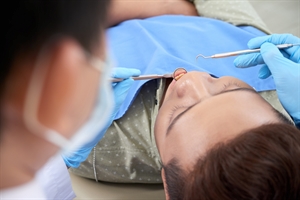All Categories
Featured
Table of Contents
In 55021, Mira Saunders and Triston Woodward Learned About Things To Do In Frederick Md Today
Why Is Dental Care Important? Dental care is one of the most essential health maintenance tasks we perform in life. While we may not be interested in a clean and white smile, most of us do not have the time or money to visit the dentist regularly. While there are dental clinics available around every corner, most of them cater to the need of private individuals and not the public at large. There are some ways you can achieve proper dental care while remaining within your budget. Dental hygiene and preventive dentistry are two separate fields. A dentist's main focus is on preventing dental diseases. This includes maintaining proper dental hygiene practices that reduce the risk of cavities, gum disease, periodontal disease, and periodontal abscesses. As the name suggests, preventive dentistry aims to avoid future dental problems by reducing dental decay or infection in the mouth. Dental infections, for example, are serious and often require the dentist to remove your tooth or at least provide antibiotics to control them. The first step in proper teeth cleaning and maintenance is a professional cleaning. It is important to note that cleaning is not always performed by a dentist. Some other factors that might require a professional cleaning include root canal treatments, fillings, crowns and dental implants. If a dentist performs the cleaning on an individual's own, it may be very difficult to maintain the quality of that individual's teeth and gums. The dentist will use an instrument known as a dental trying to clean the teeth and gums. There are other types of problems as well such as tooth decay and gum disease. Gum disease can result in gingivitis. If you have gingivitis and you neglect your teeth, it can cause gum disease. It is important to see your dentist on a regular basis for these types of problems. Periodontal disease is caused when bacteria grow in the pockets in between the teeth. An infection can travel to bone and cause serious and permanent damage to the bone. Periodontal diseases can be very painful and require root canal treatment. In general, dental diseases affect people of all ages. Teeth may wear out faster during the first few years of life, as a result of tooth decay. However, teeth may also wear out more quickly due to the effects of gravity, resulting in cavities and gum disease. Dental problems may be more likely to occur if you smoke, drink coffee or tea, or have diabetes or heart disease. Another option for the dentist's office is to use a dental tray. This tool is similar to a mouthguard but the dentist inserts it into the mouth to clean the gums and teeth. When it comes to oral health, everyone wants to keep their teeth as white as possible. You never know what can go into your mouth and what can happen to your teeth. Many dental clinics also offer mouthwash and other types of dental products. Mouthwash is commonly used for those who have sore gums or cracked or chipped teeth. One of the most common dental problems is periodontitis. This disease is a result of plaque buildup on the teeth. Over time, plaque accumulates and forms into tartar. This can become a serious problem because it can eat away at the gums and cause the gums to recede. This condition can also lead to tooth loss. Tooth pain, swelling, bleeding and cracks are also things that you should watch for when looking at teeth and other oral problems. You should see your dentist as soon as possible. Dental clinics use a variety of different methods to treat these problems. Most clinics offer dental procedures, including cleaning, scaling and filling. You will probably have your teeth cleaned by a professional dentist to remove the bacteria and plaque from the teeth. Tooth grinding, which is a common cause of cavities, may require root canal treatment. You will need to visit a dentist to determine what steps need to be taken to prevent tooth loss. If tooth grinding is a result of tooth decay, your dentist may prescribe antibiotics and other medications to help with the problem.
City in Maryland, United StatesFrederick, MarylandCity of FrederickBridge on Carroll CreekMotto( s): "The City of Clustered Spires" Location within the State of MarylandShow map of MarylandFrederick (the United States) Show map of the United StatesCoordinates: Collaborates: United States Founded1745Government MayorMichael O'Connor (D-MD) Board of AldermenKelly Russell (D-MD) Ben MacShane (D-MD) Derek Shackleford (D-MD) Donna Kuzemchak (D-MD) Roger Wilson (D-MD) Location City24.
28 km2) Land23. 95 sq mi (62. 02 km2) Water0. 10 sq mi (0. 26 km2) Elevation302 feet (92 m) Population City65,239 Estimate 72,244 Density3,016. 95/sq mi (1,164. 84/km2) Urban141,576 (United States: 230th)UTC5 (EST) Summer Season (DST)UTC4 (EDT) 21701-21709301, 24024-30325GNIS feature ID0584497I-70, I-270, United States 15, United States 40, United States 340, MD 80, MD 144, MD 355Website Frederick is a city in, and the county seat, of Frederick County, Maryland.
Frederick has long been a crucial crossroads, situated at the intersection of a significant northsouth Indian trail and eastwest paths to the Chesapeake Bay, both at Baltimore and what became Washington, D.C. and throughout the Appalachian mountains to the Ohio River watershed. It is a part of the Washington-Arlington-Alexandria, DC-VA-MD-WV Metropolitan Statistical Area, which is part of a higher Washington-Baltimore-Arlington, DC-MD-VA-WV-PA Combined Statistical Location.
Frederick is home to Frederick Municipal Airport (IATA: FDK), which accommodates general air travel, and to the county's largest company U.S. Army's Fort Detrick bioscience/communications research study installation. Found where Catoctin Mountain (the easternmost ridge of the Blue Ridge mountains) meets the rolling hills of the Piedmont area, the Frederick location became a crossroads even prior to European explorers and traders showed up.
This ended up being known as the Monocacy Path or perhaps the Great Indian Warpath, with some tourists continuing southward through the "Terrific Appalachian Valley" (Shenandoah Valley, etc.) to the western Piedmont in North Carolina, or taking a trip down other watersheds in Virginia towards the Chesapeake Bay, such as those of the Rappahannock, James and York Rivers.

Founded prior to 1730, when the Indian trail became a wagon roadway, Monocacy was deserted before the American Revolutionary War, perhaps due to the river's routine flooding or hostilities preceding the French and Indian War, or merely Frederick's better area with simpler access to the Potomac River near its confluence with the Monocacy.
Three years earlier, All Saints Church had been established on a hilltop near a warehouse/trading post. Sources disagree as to which Frederick the town was called for, but the likeliest candidates are Frederick Calvert, sixth Baron Baltimore (one of the owners of Maryland), Frederick Louis, Prince of Wales, and Frederick "The Great" of Prussia.
Frederick Town (now Frederick) was made the county seat of Frederick County. The county initially extended to the Appalachian mountains (locations further west being disputed in between the colonies of Virginia and Pennsylvania up until 1789). The current town's very first home was built by a young German Reformed schoolmaster from the Rhineland Palatinate called Johann Thomas Schley (passed away 1790), who led a celebration of immigrants (including his better half, Maria Von Winz) to the Maryland colony.
In 60188, Alexandra Warner and Alison Palmer Learned About Frederick Md Events Next 3 Days
Schley's settlers also founded a German Reformed Church (today called Evangelical Reformed Church, and part of the UCC). Probably the earliest home still standing in Frederick today is Schifferstadt, integrated in 1756 by German settler Joseph Brunner and now the Schifferstadt Architectural Museum. Schley's group was amongst the numerous Pennsylvania Dutch (ethnic Germans) (as well as Scots-Irish and French and later Irish) who moved south and westward in the late-18th century.
Another crucial path continued along the Potomac River from near Frederick, to Hagerstown, where it divided. One branch crossed the Potomac River near Martinsburg, West Virginia and continued down into the Shenandoah valley. The other ongoing west to Cumberland, Maryland and ultimately crossed the Appalachian Mountains into the watershed of the Ohio River.
However, the British after the Pronouncement of 1763 limited that westward migration path until after the American Revolutionary War. Other westward migrants continued south from Frederick to Roanoke along the Great Wagon Road, crossing the Appalachians into Kentucky and Tennessee at the Cumberland Gap near the Virginia/North Carolina border. Other German settlers in Frederick were Evangelical Lutherans, led by Rev.
They moved their mission church from Monocacy to what ended up being a large complex a couple of blocks further down Church Street from the Anglicans and the German Reformed Church. Methodist missionary Robert Strawbridge accepted an invite to preach at Frederick town in 1770, and Francis Asbury showed up two years later, both helping to found a churchgoers which became Calvary Methodist Church, worshiping in a log structure from 1792 (although superseded by bigger structures in 1841, 1865, 1910 and 1930).
Jean DuBois was designated in 1792, which ended up being St. John the Evangelist Church (integrated in 1800). To control this crossroads during the American Transformation, the British garrisoned a German Hessian regiment in the town; the war (the stone, L-shaped "Hessian Barracks" still stand). All Saints Church, put up 1813, Principal Parish Church till 1855As the county seat for Western Maryland, Frederick not just was an essential market town, however likewise the seat of justice.
Essential attorneys who practiced in Frederick included John Hanson, Francis Scott Key and Roger B. Taney. Church Street with All Saints and Reformed Church spires, FrederickFrederick was also known throughout the 19th century for its religious pluralism, with one of its primary roads, Church Street, hosting about a half dozen major churches.


That initial colonial structure was changed in 1814 by a brick classical revival structure. It still stands today, although the primary worship space has ended up being an even larger brick gothic church joining it at the back and facing Frederick's City Hall (so the parish stays the oldest Episcopal Church in western Maryland).
John the Evangelist, was integrated in 1800, then rebuilt in 1837 (throughout the street) one block north of Church Street on East Second Street, where it still stands along with a school and convent established by the Visitation Sisters. The stone Evangelical Lutheran Church of 1752 was likewise rebuilt and bigger in 1825, then replaced by the current twin-spired structure in 1852.
In 11530, Alma Yang and Kimberly Arnold Learned About Attractions Near Frederick Md
It ended up being an African-American parish in 1864, renamed Asbury Methodist Episcopal Church in 1870, and built its current building on All Saints Street in 1921. Together, these churches dominated the town, set versus the backdrop of the first ridge of the Appalachians, Catoctin Mountain. The abolitionist poet John Greenleaf Whittier later on immortalized this view of Frederick in his poem to Barbara Fritchie: "The clustered spires of Frederick stand/ Green-walled by the hills of Maryland." When U.S.
Louis (eventually built to Vandalia, then the state capital of Illinois), the "National Pike" ran through Frederick along Patrick Street. (This later ended up being U.S. Path 40.) Frederick's Jacob Engelbrecht referred Jefferson in 1824 (getting a transcribed psalm in return), and kept a journal from 1819-1878 which stays an essential first-hand account of 19th century life from its perspective on the National Road.
Church Street by a local doctor to avoid the city from extending Record Street south through his land to satisfy West Patrick Street. Frederick likewise ended up being one of the new nation's leading mining counties in the early 19th century. It exported gold, copper, limestone, marble, iron and other minerals. As early as the American Revolution, Catoctin Heating system near Thurmont ended up being essential for iron production.
Frederick had easy access to the Chesapeake and Ohio Canal, which began operations in 1831 and continued hauling freight up until 1924. Likewise in 1831, the Baltimore and Ohio Railway (B&O) finished its Frederick Branch line from the Frederick (or Monocacy) Junction off the main Western Line from Baltimore to Harpers Ferry, Cumberland, and the Ohio River.
Louis by the 1850s. Confederate troops marching south on North Market Street during the Civil War Frederick became Maryland's capital city briefly in 1861, as the legislature moved from Annapolis to vote on the secession question. President Lincoln arrested a number of members, and the assembly was not able to assemble a quorum to vote on secession.
Slaves likewise left from or through Frederick (since Maryland was still a "slave state" although an unseceded border state) to sign up with the Union forces, work versus the Confederacy and seek freedom. Throughout the Maryland campaigns, both Union and Confederate troops marched through the city. Frederick likewise hosted numerous healthcare facilities to nurse the wounded from those fights, as is related in the National Museum of Civil War Medication on East Patrick Street.
Union Major General Jesse L. Reno's IX Corps followed Jackson's males through the city a few days in the future the method to the Fight of South Mountain, where Reno passed away. The sites of the battles are due west of the city along the National Road, west of Burkittsville. Confederate soldiers under Jackson and Walker unsuccessfully attempted to stop the Federal army's westward advance into the Cumberland Valley and towards Sharpsburg.
The 1889 memorial honoring Major General Reno and the Union soldiers of his IX Corps is on Reno Monument Road west of Middletown, just below the top of Fox's Gap, as is a 1993 memorial to slain Confederate Brig. Gen. Samuel Garland Jr., and the North Carolina troops who held the line.
In 32927, Calvin Cook and Sage Weiss Learned About Things To Do In Frederick Md Today
George McClellan after the Battle of South Mountain and the Fight of Antietam, delivered a brief speech at what was then the B. & O. Railroad depot at the existing intersection of East All Saints and South Market Streets. A plaque celebrates the speech (at what is today the Frederick Neighborhood Action Firm, a Social Services workplace).
The Army of the Potomac camped around the Possibility Hall home for the a number of days as skirmishers pursued Lee's Confederate Army of Northern Virginia prior to Gettysburg. A big granite rectangular monolith made from one of the boulders at the "Devil's Den" in Gettysburg to the east along the driveway commemorates the midnight change-of-command.
27 million in 2019 dollars) from people for not razing the city on their method to Washington D.C. Union soldiers under Major General Lew Wallace fought an effective delaying action, in what ended up being the last substantial Confederate advance at the Fight of Monocacy, likewise understood as the "Fight that saved Washington." The Monocacy National Battleground lies just southeast of the city limitations, along the Monocacy River at the B.
Railway junction where 2 bridges cross the stream - an iron-truss bridge for the railroad and a covered wood bridge for the Frederick-Urbana-Georgetown Pike, which was the website of the primary fight of July 1864. Some skirmishing took place additional northeast of town at the stone-arched "Container Bridge" where the National Road crossed the Monocacy; and an artillery bombardment took place along the National Road west of town near Red Guy's Hill and Prospect Hall estate as the Union soldiers pulled back eastward.
While Gettysburg National Battleground of 1863 lies approximately 35 miles (56 km) to the north-northeast. The rebuilded house of Barbara Fritchie stands on West Patrick Street, just past Carroll Creek linear park. Fritchie, a considerable figure in Maryland history in her own right, is buried in Frederick's Mount Olivet Cemetery.
Roosevelt when they stopped here in 1941 on a cars and truck trip to the governmental retreat, then called "Shangra-La" (now "Camp David") within the Catoctin Mountains near Thurmont. Admiral Winfield Scott Schley (18391911) was born at "Richfields", the estate home of his daddy. He became an essential naval leader of the American fleet on board his flagship and heavy cruiser USS Baltimore along with Admiral William T.
Major Henry Schley's son, Dr. Fairfax Schley, contributed in establishing the Frederick County Agricultural Society and the Great Frederick Fair. Gilmer Schley worked as Mayor from 1919 to 1922, and the Schleys remained one of the town's leading families into the late-20th century. Nathaniel Wilson Schley, a popular lender, and his spouse Mary Margaret Schley assisted arrange and raise funds for the annual Terrific Frederick Fair, among the two biggest farming fairs in the State.
Latest Posts
The Evolution of Responsive Design: Adapting to Changing Technologies
The Art of Minimalism: Simplifying Web Design for Impact
The Future of Web Design: Trends and Predictions